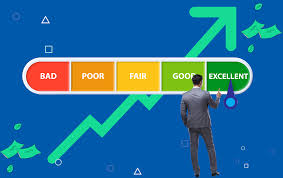How to Improve Credit Score Fast in USA (2025 Guide)
Got it 👍 Here’s a detailed, long-form article on your topic:
A good credit score is one of the most important financial tools for Americans. It affects everything—from getting approved for a loan or credit card to renting an apartment, buying a car, or even securing lower insurance rates. If your credit score is low, don’t panic—you can take steps to raise it quickly with the right strategies.
This guide will explain how credit scores work and provide step-by-step tips on how to improve your credit score fast in the USA.

Understanding Credit Scores in the USA
Credit scores in the United States are calculated by three major credit bureaus: Experian, Equifax, and TransUnion. The most commonly used scoring model is FICO Score, which ranges from 300 to 850.
- Excellent: 800 – 850
- Very Good: 740 – 799
- Good: 670 – 739
- Fair: 580 – 669
- Poor: 300 – 579
The higher your score, the better financial opportunities you’ll have.
Factors that Affect Your Credit Score:
- Payment History (35%) – Paying bills on time.
- Credit Utilization (30%) – How much of your available credit you use.
- Length of Credit History (15%) – How long you’ve had accounts open.
- New Credit Inquiries (10%) – How often you apply for new credit.
- Credit Mix (10%) – Having different types of credit (cards, loans, mortgage).
Step 1: Check Your Credit Report
- Get a free credit report from AnnualCreditReport.com (the only official free site).
- Review for mistakes like wrong balances, accounts that don’t belong to you, or missed payments you actually made.
- Dispute errors immediately—removing mistakes can boost your score quickly.
Step 2: Pay Bills on Time (Most Important Factor)
- Set up automatic payments for credit cards, utilities, and loans.
- Even one missed payment can drop your score significantly.
- If you’ve missed a payment, get current as soon as possible.
💡 Pro Tip: If you can’t pay the full amount, at least make the minimum payment to stay in good standing.
Step 3: Reduce Credit Card Balances (Lower Utilization)
- Keep your credit utilization below 30% of your total limit. Example: If your limit is $10,000, don’t use more than $3,000.
- For the fastest score improvement, aim for 10% or lower utilization.
- Pay down high balances or request a credit limit increase (but don’t spend more).
Step 4: Avoid New Hard Inquiries
- Every time you apply for a credit card or loan, lenders run a hard inquiry that can lower your score by a few points.
- Too many inquiries within a short time looks risky.
- Instead of applying for multiple cards, focus on managing existing accounts well.
Step 5: Become an Authorized User
- Ask a family member or friend with good credit to add you as an authorized user on their credit card.
- Their positive payment history and credit limit will be reflected in your report.
- This is one of the fastest ways to build or repair credit.
Step 6: Diversify Your Credit Mix
- If you only have credit cards, consider adding a small personal loan, secured credit card, or auto loan.
- Lenders like to see you can handle different types of credit responsibly.
Step 7: Use a Secured Credit Card (If You Have Bad Credit)
- A secured credit card requires a cash deposit (usually $200–$500).
- Use it responsibly—make small purchases and pay them off in full each month.
- Within 6–12 months, you’ll build a positive payment history.
Step 8: Keep Old Accounts Open
- Length of credit history matters. Don’t close old credit cards, even if you don’t use them often.
- An older account helps improve your average account age and shows stability.
Step 9: Negotiate with Creditors
- If you have late payments, call your creditor and ask for a “goodwill adjustment”.
- Some lenders may remove a late payment record if you’ve been a loyal customer.
- You can also negotiate for a debt settlement if you owe large amounts.
Step 10: Consider Credit-Building Tools
- Credit-builder loans – Offered by some banks and credit unions. You make small monthly payments, and they report to credit bureaus.
- Experian Boost – Lets you add on-time payments for utilities and streaming services to your credit report.
- Self Credit Builder App – A popular tool for people starting with no credit or poor credit.
Step 11: Monitor Your Credit Regularly
- Use apps like Credit Karma, Experian, or Mint to track your score.
- Monitoring helps you catch errors early and stay motivated.
How Fast Can You Improve Your Credit Score?
- 30 Days: Paying down balances and disputing errors can raise your score quickly.
- 3–6 Months: Consistent on-time payments start to show positive results.
- 12 Months+: Long-term habits like low utilization and old accounts boost your score significantly.
Mistakes to Avoid When Building Credit
- ❌ Closing multiple accounts at once.
- ❌ Paying only the minimum without reducing balances.
- ❌ Taking payday loans (they don’t help your score and cost more).
- ❌ Ignoring small bills (medical, phone, utilities) that can end up in collections.
✅ Final Thoughts
Improving your credit score in the USA doesn’t happen overnight, but with smart steps, you can see results within weeks or months. The fastest ways are:
- Paying bills on time.
- Lowering credit utilization.
- Fixing errors in your report.
- Becoming an authorized user.
Once your score improves, you’ll have access to better credit cards, lower loan rates, and more financial freedom. Remember, your credit score is like your financial reputation—protect it and it will reward you for years to come.









Post Comment